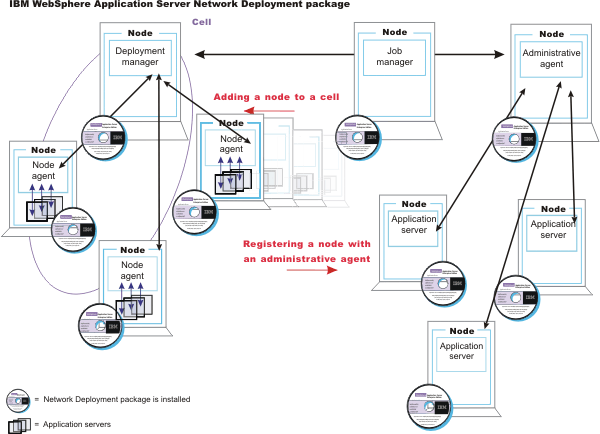Welcome to basic admin architecture
The basic administrative architecture consists of software processes called servers, topological units referenced as nodes and cells, and the configuration repository used for storing configuration information. The appserver, node agent server, dmgr, administrative agent, and job manager interact to perform system administration.
Servers perform the actual running of the code. Several types of servers exist depending on the configuration. Each server runs in its own JVM. The appserver is the primary run-time component in all WAS configurations. All WAS configurations can have one or more appservers. In some configurations, each appserver functions as a separate entity. No workload distribution or common administration among appservers exists. In other configurations, workload can be distributed between servers and administration can be done from a central point.
A node is a logical group of WAS-managed server processes that share a common configuration repository. A node is associated with a single WAS profile. A WAS node does not necessarily have a one-to-one association with a system. One computer can host arbitrarily many nodes, but a node cannot span multiple computer systems. A node can contain zero or more appservers.
The configuration repository holds copies of the individual component configuration documents that define the configuration of a WAS environment. All configuration information is stored in .xml files.
A cell is a grouping of nodes into a single admin domain. A cell can consist of multiple nodes, all administered from a dmgr server.
When a node becomes part of a cell (a federated node), a node agent server is created on the node to work with the dmgr server to manage the WAS environment on that node.
When a node is a standalone node, not part of a cell, the configuration repository is fully contained on the node.
When a standalone node is registered with an administrative agent, the configuration repository continues to be fully contained on the node.
When a node is part of a cell, the configuration and application files for all nodes in the cell are centralized into a cell master configuration repository. This centralized repository is managed by the dmgr server and synchronized to local copies that are held on each node. The local copy of the repository that is given to each node contains just the configuration information needed by that node, not the full configuration that is maintained by the dmgr.
When a dmgr is registered with a job manager, the dmgr continues to manage the centralized configuration repository.
Application Server
A WAS provides the functions that are required to support and host user applications. An appserver runs on only one node, but one node can support many appservers.
Node agent
When a node is federated, a node agent is created and installed on that node. The node agent works with the dmgr to perform admin activities on the node.
Deployment manager
With the dmgr, we can administer multiple nodes from one centralized manager. The dmgr works with the node agent on each node to manage all the servers in a distributed topology. Application server nodes are federated with the dmgr before they can be managed by the dmgr.
Administrative agent
An administrative agent provides a single interface to administer multiple unfederated appserver nodes in environments such as development, unit test or that portion of a server farm residings on a single machine. Application servers nodes are registered with the administrative agent before they can be managed by the administrative agent.
Job manager:
In a flexible management environment, a job manager allows you to submit admin jobs asynchronously for appserver nodes registered to administrative agents and for dmgrs. Application server nodes that the administrative agent or dmgr manage must be registered with the job manager before the job manager can manage them.

Related tasks
Set up the admin architecture